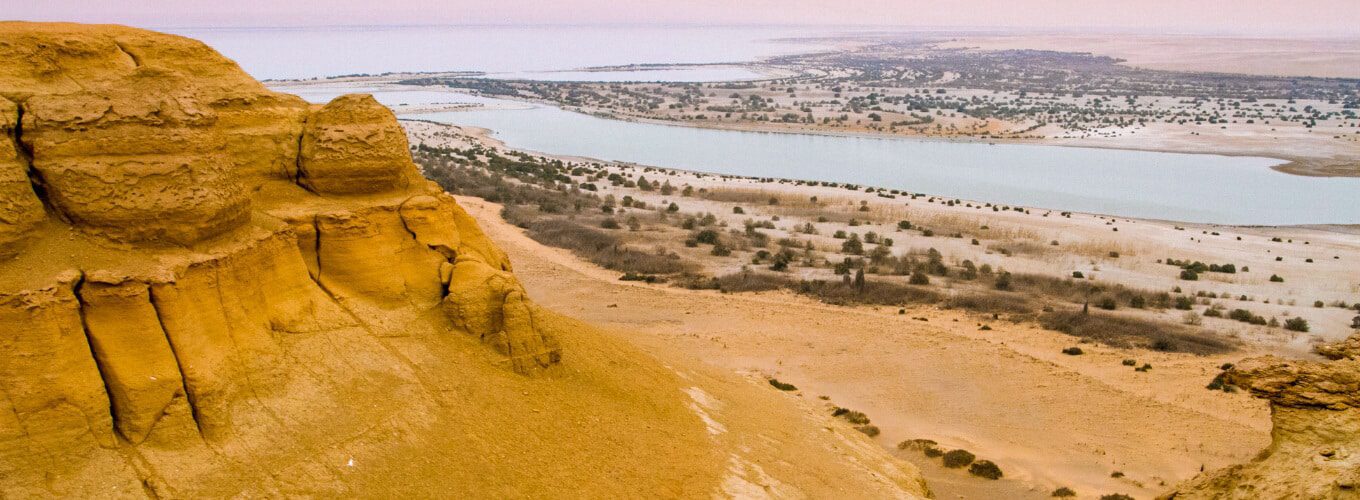Fayoum is one of Egypt’s oldest cities, so it has a lot of amazing things from the past and nature. Fayoum is 100 km south of Cairo, near Giza, and driving there takes an hour and 15 minutes. The weather in Fayoum is pleasant all year, which is a plus. There are many things to do in Fayoum and many attractions from different times in the city, such as Pharaonic, Greco-Roman, Coptic, and Islamic interests. Like Alexandria, Luxor, and Aswan.

What to do in Fayoum on as first visit?
Ancient Egypt’s Fayoum was a part of the country known for being fertile and full of plants and animals. Fayoum used to be a desert basin, but when a branch of the Nile sent water there, it turned into a lush oasis.
1- Wadi El Hitan (Whale Valley)
It is the most critical place to study evolution because it helps us figure out what happened when whales went from mammals that lived on land to mammals that lived in the water.
The Western Desert of Egypt is where Wadi El-Hitan is. As the valley’s name suggests, it has much to do with whales. It is the only place in the world where you can see the skeletons of families of ancient whales in their natural habitat. Wadi El-Hitan is known for its many fossils of both animals and other things.
With help from the United Nations, It opened its doors in 2016. It shows how the climate of the sea changed and how it changed the valley. It is considered the only Museum of its kind in the Middle East.
But the valley has more to offer than that! It has recently become a popular place for people who want to see the stars but need clear skies so if you want a trip to help you relax and unwihere’sre’s where you should go.
For a memorable experience at Wadi El Hitan (Whale Valley), follow these tips:
- Visit the fossil site to see ancient marine giants.
- Bring sunscreen and water, as it can get hot.
- Take a guided tour to learn about the fossils.
- Don’t forget your camera for stunning landscapes.
- Check the opening hours before you go.
Additional info.
Opening Times: Daily, from 9:00 AM to 4:00 PM
How to Get There: Wadi El Hitan is about 3- to 4-hour from Cairo. You can hire a private car or join a guided tour from Cairo.
Travel Tips: Wear comfortable clothing, bring sunscreen, and carry enough water. The site can get extremely hot. A local guide can enhance your experience by explaining the geological significance.
Ticket Prices: As of my last update, the entrance fee for foreigners was around 80 EGP, but it may vary.
2- Wadi El Rayan
This nature reserve is a popular site among bird watchers and sandboarding enthusiasts, home to pristine waterfalls and one of the world’s few remaining populations of the endangered slender slender-horned gazelle species. This biodiverse protectorate consists of upper and lower lakes connected by waterfalls, the biggest in Egypt.
Wadi El Rayan is a nature reserve 75 km from El Fayoum City. This reserve covered an area of 1759 km² and was announced as a protected area in 1989. Wadi El Rayan has astonishing landscapes, oases, mountains, and rock formations. The size of Wadi El Rayan is interesting for archaeologists and geologists as it is full of marine fossils and archaeological remains.
These include white gazelles, Egyptian gazelles, sand foxes, fennec foxes, and many resident and migrant birds, besides various eagles and falcons.
The location mainly comprises two lakes, an upper lake, and a lower lake, linked to the famous Wadi El Rayan Waterfalls, considered the largest waterfalls in Egypt. It also has a spring, El Rayan Mountain, Maduara Mountain, mobile dunes, and water wheels, all of which are natural features.
The location of Wadi’sdi’s natural resources is 23 square km. There are 16 kinds of desert plants and 16 types of animals and birds, like foxes, wolves, and falcons, that live in the Wadi.
Enhance your visit to Wadi El Rayan with these helpful Tips:
- Explore the two beautiful desert lakes.
- Pack a picnic for a relaxing day by the water.
- Rent a 4×4 to navigate the sand dunes.
- Look out for local bird species.
- Respect the natural environment.
Additional info.
Opening Times: Open year-round, but it’s recommended to visit during daylight hours.
How to Get There: Wadi El Rayan is around a 2-hour drive from Cairo. You can hire a taxi or join a guided tour.
Travel Tips: Respect the natural environment; it’s a protected area. There are picnic spots if you’d like to bring food.
Ticket Prices: Entrance to Wadi El Rayan is typically free.
3- Tunis Village
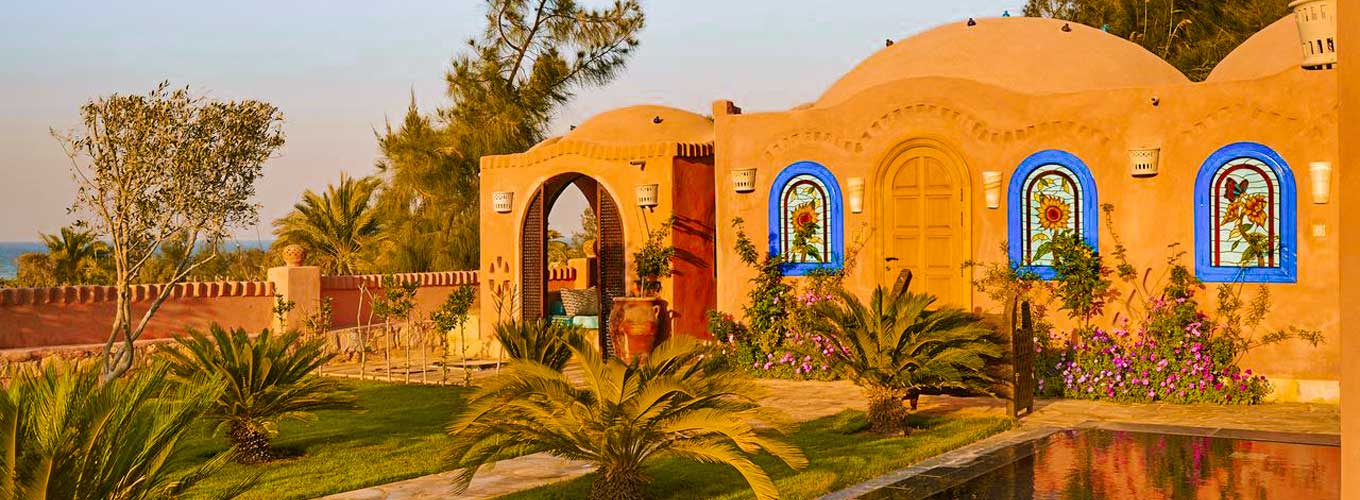
It is one of the most beautiful places in all of Egypt. It sits atop a hill overlooking Lake Qarun, the country’s second-largest lake. In the 1980s, a Swiss potter named Evelyn Porret changed the village.
She then opened a pottery studio in her home, where she taught many local people how to make pottery. Some of the best potters in the country live in the village now. People also like visiting this place to watch birds and ride horses.
Planning a trip to Tunis Village? Here’s how to make the most of it:
- Savor traditional Egyptian dishes at local cafes.
- Explore the pottery studios and art galleries.
- Buy handmade crafts as souvenirs.
- Experience the friendly hospitality of the locals.
- Plan a stay in a cozy guesthouse.
Additional info.
Opening Times: The village is open year-round, and you can explore it at your leisure.
How to Get There: Tunis Village is approximately 3 hours from Cairo by car. You can also use public transportation or hire a taxi.
Travel Tips: Enjoy the traditional charm of the village. Try local dishes at one of the restaurants.
Ticket Prices: No admission fees for the village itself.
4- Magic Lake
A lake in the middle of the desert is called “Magic Lake” because its color changes several times a day depending on how much light it reflects. There are also minerals in Magic Lake that can help people with rheumatism. In the middle of the desert, you can cool off by swimming in the lake. The area around Magic Lake in Wadi El Hitan is popular for camping and sandboarding.
The Qarun Lake is one of the oldest and most important natural lakes, and it is 20 km from Fayoum and is 1155 km long. The lake is five meters deep in the east and thirteen meters deep in the west.
Lake Qarun is also known around the world as an “Important Bird Area,” which is a place where thousands of migrating birds stop to rest on their way south for the winter. Because of these unique features, the lake is a great place to fish and watch birds, among other things.
Magic Lake awaits! Make your visit unforgettable with these tips:
- Enjoy the surreal blue waters of this desert lake.
- Go swimming, but be cautious of the depth.
- Capture the stunning reflection in your photos.
- Opt for a sunset visit for magical scenery.
- Keep the area clean and dispose of trash responsibly.
Additional info.
Opening Times: It’s a natural site, so it’s accessible year-round.
How to Get There: Magic Lake is located near Tunis Village. You can visit while exploring the village.
Travel Tips: Capture the stunning views and enjoy a tranquil atmosphere.
Ticket Prices: No specific entrance fee for Magic Lake.
5- Medinet Madi (Narmuthis)
Medinet Madi is one of many places like this, but it is the most interesting. The ruins of an ancient town called Dja during the Middle Kingdom and Narmuthis during the Ptolemaic and Roman periods can be found.
During the reigns of Amenemhat III and Amenemhat IV, a temple was built in Narmuthis to honor the snake goddess Renenutet. There are also the ruins of two more temples at Medinet Madi. These temples were built to honor the gods Sobek and Horus.
Explore Medinet Madi (Narmuthis) like a pro with these recommendations:
- Discover the ruins of this ancient city.
- Hire a local guide for historical insights.
- Wear comfortable shoes for exploring.
- Respect the archaeological site rules.
- Visit the nearby museum for artifacts.
Additional info.
Opening Times: Generally, visiting during daylight hours is advisable, but exact times may vary.
How to Get There: Medinet Madi is approximately 90 miles (145 km) from Cairo. You can reach it by car or hire a local guide who knows the way.
Travel Tips: Bring water and snacks, as amenities might be limited. Exploring with a knowledgeable guide can provide historical context.
Ticket Prices: Entrance fees can vary, but they are typically affordable.
6- Petrified Forest
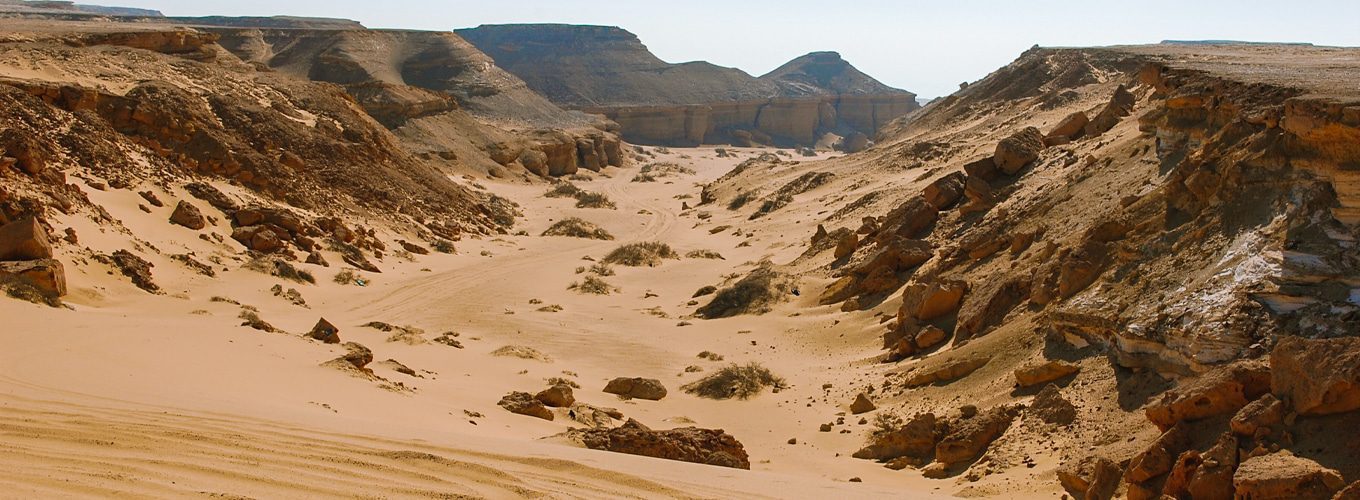
The Petrified Forest in Fayoum is one of the largest in the area and is north of Lake Qarun. The fossilized trees are thought to come from a forest that grew more than 30 million years ago. It has the fossils of trees up to 30 meters tall and a wide range of fossils, most of which are in perfect condition.
Unearth the secrets of the Petrified Forest with these tips:
- Marvel at the ancient tree fossils.
- Stay on designated paths to preserve the site.
- Bring water and a hat for sun protection.
- Visit during the cooler months for comfort.
- Learn about the forest’s history.
Additional info.
Opening Times: Generally, it’s advisable to visit during daylight hours, but exact times may vary.
How to Get There: Medinet Madi is approximately 90 miles (145 km) from Cairo. You can reach it by car or hire a local guide who knows the way.
Travel Tips: Bring water and snacks, as amenities might be limited. Exploring with a knowledgeable guide can provide historical context.
Ticket Prices: Entrance fees can vary, but they are typically affordable.
7- Al Modawara Mountain
Al Modawara Mountain is another place worth seeing in Fayoum. The mountain is west of Al Fayoum Lake. It is more of a rock formation than a mountain, with three peaks sticking out. Hill Train isn’t too hard to climb; if you do, you’ll get a great view of the area’s confusing terrain.
Most people know Jabal El Medawara for sand sports like sandboarding and hikes. Make sure to go to an excellent place for adventure and peace. At night, you can roast marshmallows and eat a B.B.Lunchnch while you watch the stars twinkle in the moonlight.
Hike Al Modawara Mountain with confidence using these Tips:
- Hike for panoramic views of the region.
- Wear sturdy shoes for the ascent.
- Bring a camera for stunning photo opportunities.
- Start your hike in the morning or late afternoon.
- Be mindful of the desert’s natural beauty.
Additional info.
Opening Times: Open year-round, but daytime visits are ideal.
How to Get There: Al Modawara Mountain is within Wadi El Rayan, so you can explore it during a trip to Wadi El Rayan.
Travel Tips: Enjoy the panoramic views of the desert and lakes from the mountain.
Ticket Prices: Covered by the entrance fee for Wadi El Rayan.
8- Qasr Qarun Temple
The Ptolemies built the temple of Qasr Qarun in 4 B.C. This temple was constructed for Sobek, the god of Al Fayoum, who has a crocodile’s head. It’s all left of the old town that used to be there. The temple has three stories and is built on a piece of land that is 180 m2. It is 65 km from Fayoum, at the western end of Lake Qarun, east of Qasr Qarun.
Except for the 21st of December, Qasr Qarun stays dark the whole year. On this day, the Winter Solstice, the sun lines up with the Holy of Holies of the temple, where statues of Sowerehere are kept and worshipped.
Unlock the beauty of Qasr Qarun Temple with these tips:
- Explore the well-preserved Greco-Roman temple.
- Admire the intricate carvings and architecture.
- Consider hiring a guide for historical context.
- Visit the nearby Qarun Lake for a scenic backdrop.
- Respect the site’s historical significance.
Additional info.
Opening Times: Generally open during daylight hours.
How to Get There: Qasr Qarun is about a 2 to 3-hour drive from Cairo. Private cars or guided tours are common options.
Travel Tips: Explore the well-preserved temple and its historical significance.
Ticket Prices: Entrance fees may apply, but they are usually affordable.
9- Hawara Pyramid
The village of Hawara is 9 km from Fayoum, and Hawara is the Pyramid of Hawara. In ancient times, the town of Townage was called Hat Wa’art, which means “the footrest.”
In ancient Egypt, the Pyramid of Hawara was built for Amenemhet III of the 12th Dynasty, and it is about 9 kilometers east of the oasis of Fayoum. This Pyramid was made of brick stones; then white limestone was put on top. The only part of the Pyramid still stands today is the brick core, which is why it is sometimes called the “black Pyramid.”
The Pyramid of Hawara is built in a way that is different from how other Pyramids are, and it is thought to have been influenced by the Step Pyramid of Saqqara. Also, the entrance to the Pyramid is on the southern side, while the doors to the other Pyramids are on the north.
Prepare for an adventure at Hawara Pyramid with these Tips:
- Visit this unique pyramid with a different design.
- Take time to explore the nearby archaeological site.
- Bring water and wear sunscreen.
- Be prepared for limited facilities in the area.
- Check opening hours before your visit.
Additional info.
Opening Times: Generally, it’s best to visit during daylight hours.
How to Get There: Hawara Pyramid is around a 2-hour drive from Cairo. Private cars or guided tours are common transportation options.
Travel Tips: Explore the pyramid, and don’t forget to learn about its historical significance.
Ticket Prices: Entrance fees may apply, but they are typically affordable.
10- The Meidum Pyramid
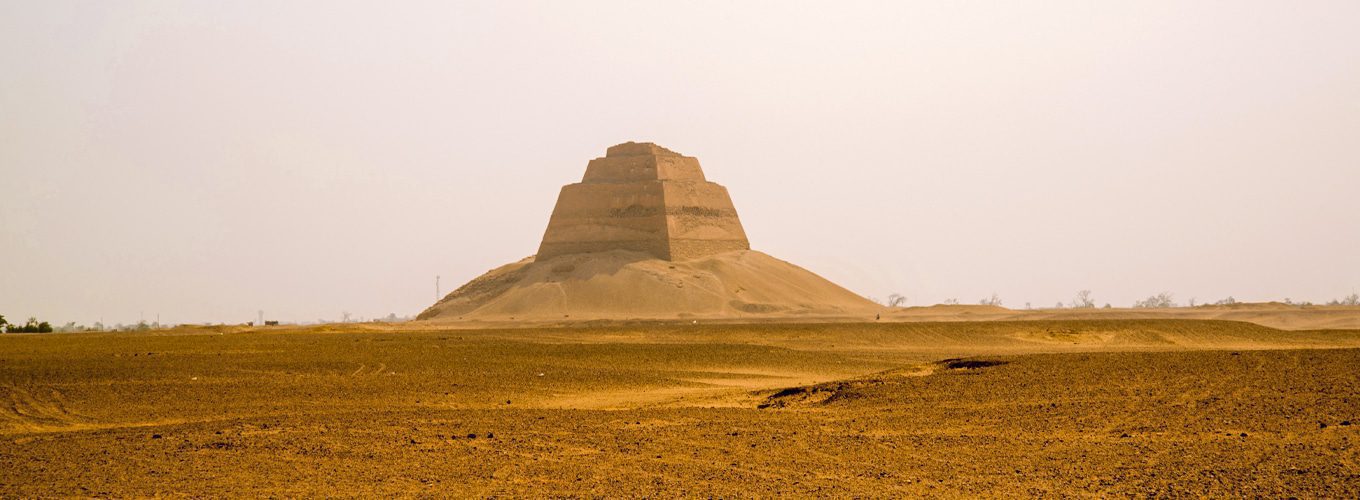
Most people think that Huni, the last king of the third dynasty, built the Pyramid of Meidum, even though his name doesn’t appear anywhere on the Pyramid. Some people think it might have belonged to his son Sneferu because his name is written on a small temple at the site. It’s also possible that Huni started building, but Sneferu finished it since Sneferu already had two Pyramid complexes at Dahshur.
At first, the Pyramid of Meidum was a step pyramid, but it was later changed into a true pyramid. This Pyramid is 30 km from Fayoum and marks the end of the Early Dynastic Period and the beginning of the Old Kingdom. The Pyramid of Meidum was the first genuine attempt by the ancient Egyptians to build a pyramid, but it was not very well made. Because of this, the sides of the Pyramid fell sometime after it was built. Today, only the core of the building is left, but it is still a beautiful sight to see.
If you want to see this exciting landmark, don’t take public transportation because it’s hard to find. Taking a taxi is your best bet.
Climb the Meidum Pyramid with these helpful tips in mind:
- Explore the stepped pyramid’s fascinating history.
- Climb to the top for an incredible view.
- Be cautious on the uneven steps.
- Hire a local guide to learn about its mysteries.
- Capture stunning photos of the pyramid.
Additional info.
Opening Times: It’s advisable to visit during daylight hours.
How to Get There: The Meidum Pyramid is approximately a 2 to 3-hour drive from Cairo. Private cars or guided tours are recommended.
Travel Tips: Discover the unique stepped pyramid structure and its history.
Ticket Prices: Entrance fees may apply, but they are usually budget-friendly.
11- Lahun Pyramid
Sensret II, who ruled Egypt during the 12th dynasty, built the Pyramid of Lahun around 4000 years ago. Like the Pyramid of Meidum, this has an entrance on the southern side, which is unusual since most of Egypt’s Pyramids have entries on the northern side.
The Pyramid of Lahun is on a 12-meter-high hill 22 km from the Fayoum governorate, and British archaeologist William Petrie found it in 1889. The Egyptian government just finished fixing the Pyramid, which will be open to the public for the first time in June this year.
Discover the mysteries of Lahun Pyramid using these Tips:
- Explore the pyramid and its unique design.
- Hire a guide to understand its historical significance.
- Dress comfortably for a day of exploration.
- Capture the scenic beauty of the surrounding area.
- Respect the site’s historical and archaeological importance.
Additional info.
Opening Times: Typically open during daylight hours.
How to Get There: Lahun Pyramid is around a 2 to 3-hour drive from Cairo. Private cars or guided tours are the common modes of transportation.
Travel Tips: Explore the pyramid and its historical context.
Ticket Prices: Entrance fees may apply, and they are usually affordable.

12- Fayoum Waterwheels
If you like going to places in the countryside, this is the place for you. In the valley around Fayoum, there are more than 200 waterwheels. Since the time of the Gerco Romans, these waterwheels made of white wood and called “Azizy” have kept the fields in Fayoum well-watered. The wheels keep turning as the river current pushes through the wide paddles. When the water reaches the top of the edge boxes, they pick it up and pour it out of the holes on their sides into a pipe that goes out to the fields.
The village of Basiouniya, 14 km east of Fayoum, is home to the largest of these wheels. This waterwheel gives 37 hectares of land used for farming clean water.
The enormous waterwheel in the city is fixed every year in mid-January when the water flow is at its lowest. The people of the village get together once every six years to change this wheel.
Maximize your visit to the Fayoum Waterwheels with these tips:
- Witness the iconic Norias (waterwheels) in action.
- Visit in the early morning for a serene experience.
- Learn about the local irrigation system’s history.
- Support local artisans by purchasing handcrafted items.
- Enjoy a boat ride along the Bahr Yussef canal.
Additional info.
Opening Times: You can visit the waterwheels during the day.
How to Get There: Fayoum Waterwheels are scattered throughout the region, so you can explore them while touring the area.
Travel Tips: Enjoy the scenic beauty and capture photos of these traditional waterwheels.
Ticket Prices: There are typically no specific entrance fees for the waterwheels.
13- Karanis Open-Air Museum (Kom Oshim)
An open-air museum at the edge of Fayoum Oasis, in the Karanis archaeological site. The exact location is 35 kilometers north of Fayoum city. It has pieces of monumental buildings and stone sculptures from the time of the Pharaohs. Some things on display are pieces of Crocodilopolis, which was once a significant city.
Immerse yourself in history at Karanis Open-Air Museum (Kom Oshim) with these Tips:
- Discover well-preserved Roman ruins.
- Hire a guide to delve into the history.
- Bring comfortable footwear for exploring.
- Respect the archaeological site’s rules.
- Enjoy the peaceful, open-air atmosphere.
Additional info.
Opening Times: Open during daylight hours.
How to Get There: Karanis Open-Air Museum is accessible by car from Cairo, or you can visit it as part of a Fayoum tour.
Travel Tips: Explore the ancient ruins and get insights into the history of this site.
Ticket Prices: Entrance fees are typically reasonable.
14- Fossil & Climate Change Museum
Located in Fayoum shows artifacts from the past and teaches people about problems in the present.
This is the first Museum in the Middle East that is all about fossils. The 18-meter-long skeleton of a Basilosaurus Isis whale is essential in the Museum. The Museum also shows how climate change has changed Wadi El-Hitan in a big way. If you have a ticket for Wadi El-Hitan, you don’t have to pay anything extra to get into the Museum.
Explore the wonders of the Fossil & Climate Change Museum with these tips:
- Learn about Egypt’s prehistoric past.
- Explore fossil exhibits and climate change displays.
- Consider it a great educational stop for all ages.
- Engage with interactive exhibits for a deeper understanding.
- Support the museum’s conservation efforts.
Additional info.
Opening Times: Open during daylight hours.
How to Get There: The museum is located near Qarun Lake in Fayoum. You can visit it as part of a tour of the region.
Travel Tips: Learn about fossils and climate change in the area.
Ticket Prices: Entrance fees are usually affordable.
16- Qasr El Sagha Temple
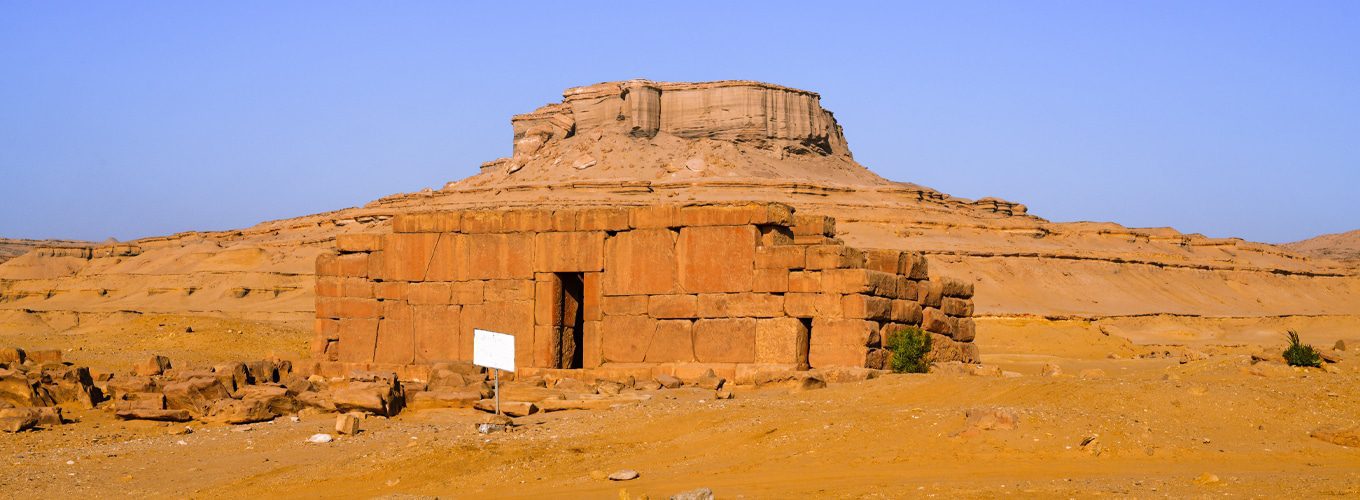
This temple is hidden in a desert north of Qarun Lake. Locals call it Qasr El-Sagha, a small temple shaped like a rectangle with no writing. The Temple of Qasr El Sagha is made of large blocks of sandstone from the area that is not all the same size.
The temple has seven small rooms and one room you can’t enter. There are different ideas about when the temple was built. The walls of the temple were never decorated because it was never finished.
Step into the past at Qasr El Sagha Temple with these helpful hints:
- Admire the ancient temple’s architecture.
- Take time to explore the surrounding ruins.
- Wear comfortable clothing for site visits.
- Consider hiring a guide for historical insights.
- Respect the cultural and historical significance.
Additional info.
Opening Times: Open during daylight hours.
How to Get There: Qasr El Sagha Temple is a few hours’ drive from Cairo and can be reached by private car or as part of a guided tour.
Travel Tips: Explore the ancient temple ruins and the surrounding area.
Ticket Prices: Entrance fees may apply, and they are usually budget-friendly.
18- Fayoum Art Center (Caricature Museum)
The Middle East has never had anything like the Caricature Museum before. As part of the Fayoum Art Center, it was started by caricature artist Mohamed Abla in 2010. Abla decided to put his unique Museum in the village of Tunis, which is 60 km from Fayoum. The Museum is only a few steps from the entrance to the town, and it is known as a place where people can be creative.
The Museum is built of yellow stones and has a dome-like ceiling. It is surrounded by trees and flowers, which make it even more beautiful.
Enjoy a visit to the Fayoum Art Center with these suggestions:
- Experience local art and creativity.
- Attend art exhibitions and workshops.
- Purchase unique artwork as souvenirs.
- Interact with local artists and learn about their craft.
- Check the center’s event schedule for special activities.
Additional info.
Opening Times: Open during business hours, typically from morning to late afternoon.
How to Get There: The art center is located in Fayoum City, and you can easily reach it by car or taxi.
Travel Tips: Discover local art and culture in Fayoum.
Ticket Prices: Entry is often free or may require a small donation.
19- The Fayoum Portraits
People’s faces were painted on the coffins of Roman mummies, the Fayum Funeral Portraits. These portraits were painted in a classical style on wood or canvas, making them some of the most beautiful classical paintings in the world.
There were 900 portraits of Romans found in Egypt, most of them in Fayum, which is why they are called “Fayum Portraits.” Egypt is hot, so the portraits were still in good shape when they were found. Influential and well-known people are thought to have lived at this time. Portraits of the Fayum mummies can be seen in the world’s most important archaeological museums.
Uncover the beauty of The Fayoum Portraits with these helpful tips:
- Discover ancient mummy portraits at the museum.
- Learn about the unique art style and history.
- Capture the beauty and realism of the portraits.
- Consider hiring a guide for cultural insights.
- Respect the historical importance of the artifacts.
Additional info.
Opening Times: You can view the portraits during daylight hours.
How to Get There: The Fayoum Portraits can be seen while exploring the region and its museums.
Travel Tips: Explore the ancient Egyptian portraits and their historical significance.
Ticket Prices: Entrance fees may apply at certain museums.
souvenirs.
FAQ – Frequently Asked Questions
Is Al-Fayoum worth visiting?
Egypt’s Faiyum Governate has many things to see and do that make it well worth a visit.
How do you spend a day in Fayoum?
- Wadi El-Rayan
- Lahun Pyramid.
- Pyramid of Sneferu.
- Hawara Pyramid.
- Qasr Qarun and Medinet Quta.
- Karanis.
What is remarkable in Fayoum?
The Fayoum is one of the most beautiful and fertile parts of Egypt, and it is less than 100 kilometers from Cairo and has a rich history of plants, animals, and archaeology. It also has the Lake Qarun National Park and the Wadi Rayan National Park, both protected areas by the Egyptian government.
Can you swim in Fayoum?
Deserts are all around this beautiful place. People hike and sandboard near Magic Lake; some even swim there. Minerals in the lake are said to help people with rheumatism feel better. It’s just a magical place where you can have a magical trip.
How long is Fayoum from Cairo?
From Cairo to Fayoum is about 95 km.
What is the climate in Fayoum?
Al Fayoum has long, hot, dry, and mostly clear summers and short, cool, dry, and mostly clear winters. Most of the time, the temperature ranges from 48°F to 95°F over a year, and it rarely goes below 43°F or above 102°F.
What is the meaning of Fayoum?
A style of portrait painting grew up in Egypt when the Romans ruled it. Examples of this style have been found mainly in Faiyum from the 2nd and 3rd centuries a.d., and are characterized by the frontality of the head, the modeling of form, and the focus on the eyes.
